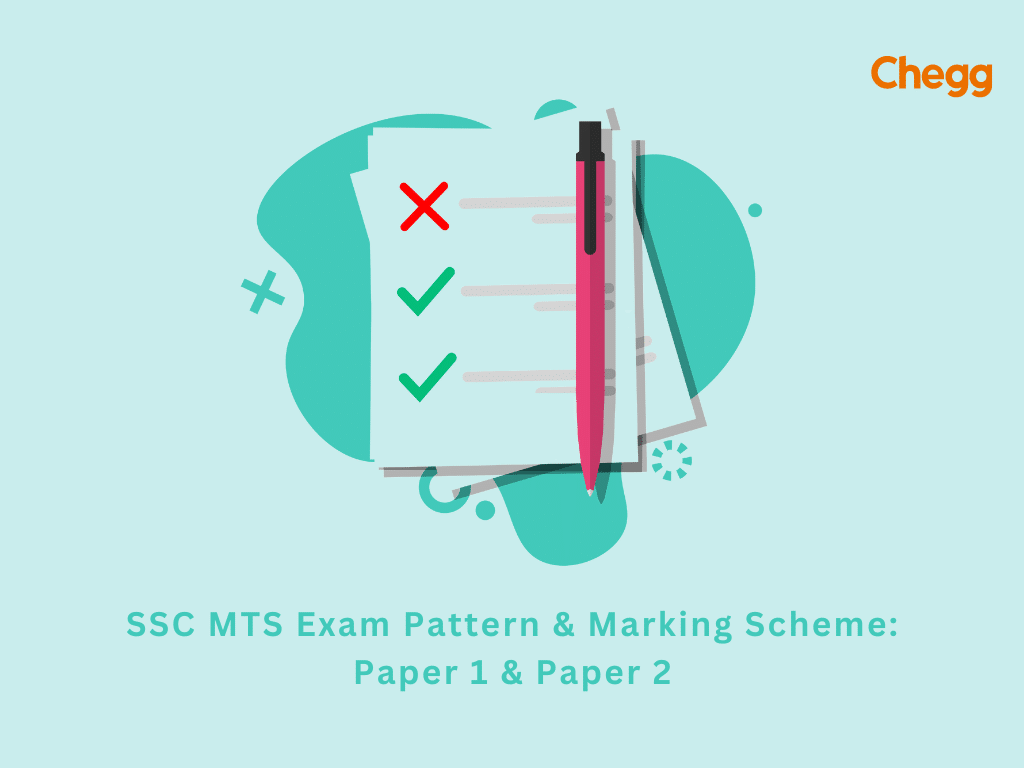Home » Govt Exams Blogs » SSC MTS Exam Pattern 2024 & Marking Scheme: Paper 1 & Paper 2
SSC MTS Exam Pattern 2024 & Marking Scheme: Paper 1 & Paper 2

Table of Contents
Table of Contents
The full form of SSC MTS means the SSC MTS (Staff Selection Commission Multi Tasking Staff) exam is a national-level examination conducted by the SSC. Candidates need to prepare per the SSC MTS exam pattern & marking scheme to qualify. As per the SSC MTS Notification For the 2024 Exam, there are approx 10880 vacancies with 529 vacancies for the Havaldar post. The official notification for SSC recruitment MTS 2024 is yet to be released.
Knowing the SSC MTS syllabus and MTS for SSC exam pattern can help you to prepare effectively and efficiently for the exam.
SSC MTS Exam 2024: Overview
Here is an overview of the SSC MTS exam 2024:
| Exam Name | SSC MTS |
| Conducting Body | SSC |
| Level | National |
| Exam Mode | Paper I: Computer-Based Exam (CBE) Physical Standards (PET/PST): Offline |
| Language | CBE is conducted in Hindi, English, and in the following 13 regional languages: (i) Assamese. (ii) Bengali. (iii) Gujarati. (iv) Kannada. (v) Konkani. (vi) Malayalam. (vii) Manipuri. (viii) Marathi. (ix) Odia. (x) Punjabi. (xi) Tamil. (xii) Telugu. (xiii) Urdu. |
| Eligibility Criteria | Candidates must have passed 10th std. or its equivalent from a recognized board with a minimum of 50% marks. |
| Frequency of Exam | Once a year. |
| Minimum Qualifying Marks In CBE For Both Session I and Session II | UR: 30% OBC/EWS: 25% All other categories: 20% |
This blog will provide the revised SSC MTS exam pattern and marking scheme for 2024 to aid your preparation.

SSC MTS Exam Pattern: Paper 1
Here is the SSC MTS exam pattern for Paper 1 which is a Computer Exam that highlights the number of questions in the MTS exam, Maximum marks for the SSC recruitment MTS 2024, subjects & SSC MTS syllabus 2024 along with the time duration to complete the MTS test paper. Read below:
| Part | Subject | Number of Questions | Maximum Marks | Time Duration |
| Session-I | Numerical and Mathematical Ability | 20 | 60 | 45 Minutes (60 for scribes) for both subjects. |
| Reasoning Ability and Problem-Solving | 20 | 60 | ||
| Session-II | General Awareness | 25 | 75 | 45 Minutes (60 for scribes) for both subjects. |
| English Language and Comprehension | 25 | 75 | ||
| Total | 4 Subjects | 90 | 270 | 90 Minutes |
SSC MTS Paper 2 Exam Pattern
Exam Pattern for PET & PST SSC MTS
Once you have qualified for the CBE of the SSC MTS exam, you will need to appear for the Physical Efficiency Test (PET) and Physical Standard Test (PST) if you applied for the post of Havaldat in CBIC and CBN.
Here are the requirements for the PET MTS exam of SSC:
| Particulars | Male | Female |
| Walking Distance | 1600 meters (1.6 km) | 1000 meters (1 km) |
| Time Limit | 15 minutes | 20 minutes |
Here are the requirements and relaxations for PST:
| Gender | Height | Height Relaxation | Weight | Weight Relaxation | Chest |
| Male | 157.5 cm | 5 cm (Garhwalis, Assamese, Gorkhas, and members of Schedule Tribes) | N/A | N/A | 81 cm (fully expanded with a minimum expansion of 5 cm) |
| Female | 152 cm | 2.5 cm (Garhwalis, Assamese, Gorkhas, and members of Schedule Tribes) | 48 kg | 2 kg (Garhwalis, Assamese, Gorkhas, and members of Schedule Tribes) | N/A |

SSC MTS Exam: Marking Scheme 2024
Now comes the SSC MTS marking scheme of the exam for which the MTS answer key and SSC MTS Results depend. The marking scheme provides
- Valuable information about the distribution of marks.
- The weightage of each question.
- The evaluation criteria were used to assess the answers.
The table below shows the marking scheme of the SSC MTS exam 2024:
| Exam Paper | Session | Total Questions | Marking Scheme | Maximum Marks |
| Paper 1 | Session-I | 40 | Correct Answer: +3 Incorrect Answer: 0 | 40*3=120 |
| Session-II | 50 | Correct Answer: +3 Incorrect Answer: -1 | 50*3=150 | |
| Physical Standards Test (For the post of Havaldar) | PET/PST | – | Qualifying in nature | Qualifying in nature |
SSC MTS: Calculate Your Score
To calculate the total score secured in the SSC MTS exam, the following formula is used:
Total Score = Number of Correct Answers X 3 – Number of Incorrect Answers X 1
Conclusion
SSC conducts the MTS exam for the recruitment of non-technical staff in various government departments and offices. Understanding the complete SSC MTS exam pattern is crucial for effective preparation. It helps in managing time, improving accuracy, and identifying areas for improvement.
Knowing the marking scheme can help in time management, accuracy, preparation, and self-evaluation. Therefore, you must thoroughly understand the exam pattern of SSC MTS and the marking scheme to perform well in the exam.
Frequently Asked Questions (FAQ’s)
The SSC MTS new exam pattern 2024 will consist of a Computer Based Exam (CBE) and Physical Tests. The SSC MTS exam pattern for CBE consists of MCQs from General English, General Intelligence & Reasoning, Numerical Aptitude, and General Awareness. The physical tests (PET/PST) are for the Havaldar posts only.
According to the 2024 SSC MTS exam pattern the CBE consists of 90 questions with a maximum mark of 270. And, Physical Tests are qualifying in nature.
As per the revised 2024 SSC MTS exam pattern, there is no typing test at any stage of the SSC MTS exam.
There is only one stage called Paper 1 (CBE) according to the SSC MTS new exam pattern 2024. However, for the post of Havaldar in CBIC and CBN you need to appear for the Physical Efficiency Test (PET)/ Physical Standard Test (PST).
As per the SSC MTS recruitment 2024, the lowest take-home salary of SSC MTS is approximately INR 18000 to 22000.
No, there is no interview at any stage in the SSC MTS exam as per the latest SSC selection process.